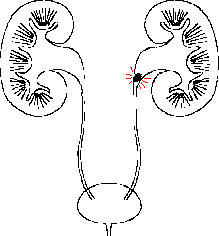Kidney stones typically present with excruciating pain but may cause a wide variety of symptoms.
What are kidney stones?
Kidney stones can form anywhere within the urinary tract, within the kidney, within the ureter (the tube draining urine from the kidney), or in the bladder. Kidney stones may be many sizes and shapes. They may be tiny microscopic crystals to stones as large as potatoes.
What are kidney stones made of?
- Calcium is present in nearly all stones (80%), usually as calcium oxalate or less often as calcium phosphate.
- Struvite stones form in the presence of urine infection and are made of a mixture of calcium, ammonia and phosphate (struvite). A staghorn calculus is very large struvite stone and takes the shape of the kidney itself.
- Uric acid stones form from the substance which causes gout.
- Cystine stones are rare and occur in an inherited condition called cystinuria
Who gets kidney stones?
Stones are common but your sex, age, diet, climate, and genetic makeup will determine your chance of getting a stone during your life. Some studies suggest that over a lifetime one in ten men and one in twenty women will develop a stone. Once you have experienced a kidney stone you have an increased chance of developing another one. You are more likely to have a stone if:
- You are male. Men are 3 times more likely than women to get a stone
- You are 30-60 years old
- You live in a hot climate
- You are white
- If a family member has had a stone
- If you suffer from high blood pressure
How do kidney stones form?
Every stone that develops is the result of a combination of factors. The chemicals that form stones are normally dissolved in the urine, however if they become concentrated in the urine crystals begin to form. A stone is a hard mass formed from crystals which grow in size and stick tightly to the inner surfaces of the kidney. Stones are more likely to form if the urine is concentrated (small volume), or if there is infection in the urine. Some people may form kidney stones because there is increased amount of a stone forming substance in the urine. Occasionally a stone forms because there are cysts or scars in the kidney.
What problems are caused by kidney stones?
The most common first symptom of a kidney stone is severe pain. This often occurs as the stone starts to move from the kidney to the ureter or bladder.

Click to see this animated in a larger picture (may take a while, 270k. The image comes from the NIDDK (link at foot of page)
The pain often comes in spasms known as colic. It starts in the back and can move into the groin. There may be blood in the urine and you may feel sick.
If a stone is present there is an increased chance of infection. Large stones like staghorns may affect kidney function even before any symptoms occur.
Serious complications arise if the stone completely blocks the flow of urine from the kidney, which then stops working.
How are kidney stones treated?
The aims of treatment are to improve symptoms, deal with any complications, remove stones which don’t pass spontaneously and prevent further stones forming.
Immediate treatment of kidney stones
Pain control is the most important part of treatment and strong painkillers are sometimes needed. You may need medication to prevent sickness or intravenous fluids. Most small stones (<5mm) will pass on their own. It is very helpful to keep any stones that are passed for analysis.
Some stones between 5-9mm will pass but larger stones need special treatment. All the treatments for removing kidney stones need to be done in a specialist centre.
Most kidney stones can be seen on an X-ray of the lower end of the abdomen. Some stones however don’t show up on plain X-ray and need a special test called an IVP (intravenous pyelogram) showing up the kidneys, ureter and bladder. CT scans can also show kidney stones. All these tests involve X-rays. Some kidney stones show up on an ultrasound scan. These tests will help decide if the pain has been caused by a kidney stone.
Certain tests may be needed to find out why you have formed a stone. This is particularly important if you have had more than one stone. You will need a series of blood tests and urine tests. These tests will measure substances in the blood and urine which if present in excessive amounts makes you more at risk of forming a kidney stone.
Treatment to remove a kidney stone
ESWL (extra-corporeal shockwave lithotripsy) is very useful for stones in the kidney or upper ureter. Shock waves are directed by a probe placed on he tummy or back . This shatters the stone into small fragments which then can be passed spontaneously. If this does not work surgery can be used.
Nephrolithotomy makes a small tract from the skin to the kidney and removes the stone using special “keyhole” instruments.
Bladder stones are removed using a cystoscope, a special instrument which is passed through the urethra into the bladder.
Diseases causing kidney stones
Further information
The following EdRenINFO pages are particularly relevant:
Here are some other websites that give useful information about kidney stones:
- NIDDK has an excellent and detailed section on kidney stones
- More information about oxalosis and hyperoxaluriacan be found through this organisation
- There is a cystinuria support network for patients which includes some links to other sites.
Acknowledgements: The authors of this page were Gemma Browne and Liam Plant. It was first published in January 2001. The date is was last modified is shown in the footer.
